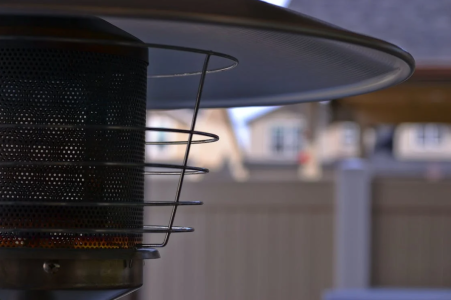Stay warm for less! Energy experts reveal which heaters won't hurt your wallet
As winter creeps in and temperatures start to drop, many of us are inevitably reaching for our heaters to chase away the chill. However, energy bills during this season can be quite brutal to our wallets. While the recent budget announced an energy bill relief package, many Australians are still seeking ways to stay warm without breaking the bank. After all, according to the Australian Government, heating and cooling can contribute to a staggering 20 to 50 per cent of energy used in homes.
But fear not, our wise Seniors Discount Club members! We've consulted with various experts to bring you the ultimate guide to choosing the best, most cost-effective heaters out there. We've also tossed in some handy tips on how to make small yet energy-saving changes to your home, so you can stay toasty all season long.

Some energy-efficient options include:
Rinnai Titan Unflued Natural Gas Radiant Heater $1199
Dimplex Electric Fire Heater $499
De’Longhi Tower Ceramic Heater $219 (sale price)
Dyson Hot+Cool Fan Heater $699 (sale price)

In summary, a combination of selecting the right heater and adopting some energy-saving tactics can help you enjoy a warm and comfortable winter without the dreaded energy bill shock.
What are some of your favourite energy-saving tactics or unique ways you have found to balance warmth and affordability during the winter season? Share your wisdom with your fellow club members and ignite a spark of inspiration in the quest for cosy and cost-effective winters!
But fear not, our wise Seniors Discount Club members! We've consulted with various experts to bring you the ultimate guide to choosing the best, most cost-effective heaters out there. We've also tossed in some handy tips on how to make small yet energy-saving changes to your home, so you can stay toasty all season long.

Our wallets can take quite a hit from the harshness of energy bills due to our heaters during this season. Source: Brett Sayles/Pexels
Top Tips for Picking the Right Heater for Your Home
Choosing the most efficient heater for your home might seem daunting with so many options available in the market. Colin Jones, Category Expert at Appliances Online, has graciously shared four key factors to consider when looking for the ideal heater:- Understand the desired room: Assess the room size, and consider whether you have a gas connection or require an electric heater. Also, are you planning to use the heater continuously or just at specific times?
- Insulation is key: Proper insulation helps retain warmth in your room and prevents the need for high heat levels, as heat can escape through the ceiling otherwise.
- Go for versatility: Opt for a heating system that can be used all year round, such as Split Systems.
- Embrace the timer function: Find a heater with a timer feature that can automatically switch on/off after a set period.
A Quick Comparison of Heating Options
To help you decide the most suitable heating option for your home, let's compare some of the most popular options available:- Panel heaters: These heaters, with a daily running cost of $1.00, are perfect for large areas like lounge rooms. Some models are portable, while others can be wall-mounted. The quarterly running cost of panel heaters amounts to $91.
- Fan heaters: Appliances Online recommends fan heaters for smaller spaces like bedrooms and home offices. A portable fan heater costs nearly $220 to run throughout winter, which makes reverse cycle split systems more efficient, as they cost only $50 for the same period.
- Oil column heaters: The quarterly running cost of these heaters is approximately $136.50.
- Radiant heaters: These heaters have a quarterly running cost of around $163.80.
Some energy-efficient options include:
Rinnai Titan Unflued Natural Gas Radiant Heater $1199
Dimplex Electric Fire Heater $499
De’Longhi Tower Ceramic Heater $219 (sale price)
Dyson Hot+Cool Fan Heater $699 (sale price)
Extra Tips to Stay Warm and Save Energy
If you already have a heater or just want to further reduce energy costs, consider these additional tips:- Get an electric throw: Origin Energy claims that electric throws are less expensive to run than heaters and can save you about $150 throughout winter.
- Maintain a temperature of 18-20 degrees: Origin and Compare the Market suggest heating your room within this range, as temperatures above or below this threshold may consume up to 10 per cent more energy.
- Use door snakes: These simple draft-stoppers can help retain heat and reduce heating costs by up to 25 per cent, as stated by Origin Energy spokespeople.
- Be energy-savvy: Implement small changes like using energy-efficient lighting, turning off unused appliances, heating only occupied rooms, and opening or closing curtains to trap heat effectively.
Key Takeaways
- Heating can account for 20 to 50 per cent of energy used in homes, so choosing the right heater can save money.
- Various types of heaters are available, including panel heaters, fan heaters, oil column heaters, and reverse cycle split systems. Reverse cycle split systems and panel heaters appear to be the most cost-effective options.
- In addition to choosing the right heater, staying warm efficiently can also be accomplished by using electric throws, keeping the heating to 18-20 degrees, using door snakes, and being energy-efficient in other areas like lighting and appliance use.
- Making small changes in your home and choosing the right heater for your needs can help you save energy while staying warm in the colder months.
In summary, a combination of selecting the right heater and adopting some energy-saving tactics can help you enjoy a warm and comfortable winter without the dreaded energy bill shock.
What are some of your favourite energy-saving tactics or unique ways you have found to balance warmth and affordability during the winter season? Share your wisdom with your fellow club members and ignite a spark of inspiration in the quest for cosy and cost-effective winters!








